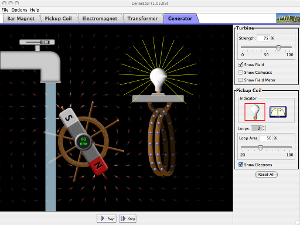Lenz's law
Lenz's law is an important concept in electromagnetism, which states that when a voltage is created by a change in magnetic flux, the induced voltage must create a current whose magnetic field is in opposition to the change which produces it.[1]
The induced magnetic field is always arranged so that a loop of wire with the induced current has constant magnetic flux. The practical use of this law is almost endless, and is how electrical generators work. With the sole exception of photovoltaic cells, every man-made power source such as dams, nuclear power plants, and natural gas plants transfer the energy from their fuel or flow into useful electricity by these generators, which can be understood by the PhET simulation below. The generator produces an alternating current, which is what 99% of the world's electricity grid uses.[2]
To learn more about Lenz's law, visit hyperphysics.
References
- ↑ Hyperphysics, Faraday's Law [Online], Available: http://hyperphysics.phy-astr.gsu.edu/hbase/electric/farlaw.html
- ↑ Hydro Quebec, Direct Current and Alternating Current [Online], Available: http://www.hydroquebec.com/learning/notions-de-base/continu-alternatif.html


